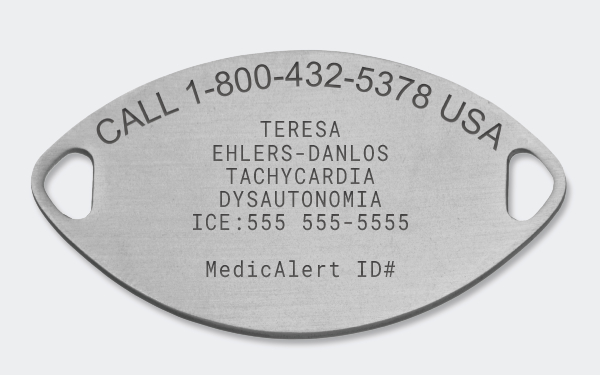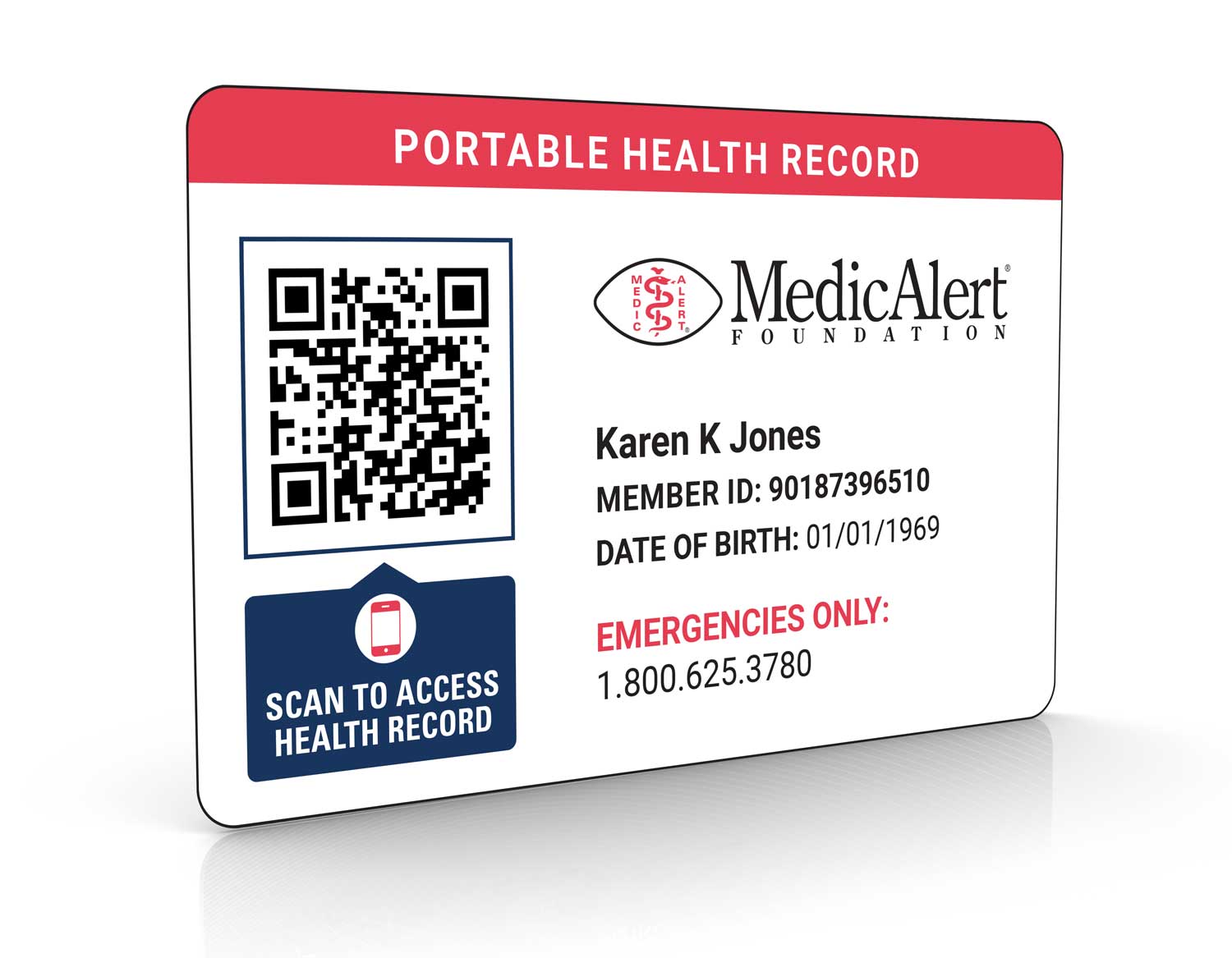Being a MedicAlert member is very worthwhile. If you have any allergies, diabetes, or just simply take any medication - you should have a MedicAlert ID. It is the best way to go. I am very happy with my MedicAlert ID and membership plan.
Linda Smethers, MedicAlert member

Medical IDs for Ehlers-Danlos syndromes
The confidence to live with Ehlers-Danlos syndrome
Ehlers-Danlos syndrome (EDS) describes a collection of related connective tissue disorders. These are all a result of a genetic disorder that affects the protein collagen, which helps create both strength and flexibility in different parts of the body.
Because of the problems with collagen that happen in Ehlers-Danlos, people that have been diagnosed with this syndrome can experience a range of symptoms, from joint and skin issues to more serious health complications.
Medical IDs for Ehlers-Danlos syndrome can be extremely helpful for people living with the condition, and allow for up-to-date medical history to be instantly available to healthcare providers.
How MedicAlert protects those living with Ehlers-Danlos syndrome
One thing you shouldn’t worry about is what could happen if there’s an emergency. MedicAlert’s protection plans offer benefits that extend beyond the ID, providing safety and peace of mind for people living with Ehlers-Danlos syndrome, their families and caregivers.

24/7 Emergency Response
Our team provides first responders the information they need to provide fast, accurate care.

Digital Health Profile
All your vital information, all in one place for you and your caregiver.

Emergency Contact Notification
In an emergency, we connect families so that no one is alone in a crisis.

Patient Instructions
Share the information that’s important to your care, such as use of rescue medications or contraindication for tests like MRIs.
Pair a medical ID for Ehlers-Danlos syndrome with the protection plan that’s right for you.
What exactly is Ehlers-Danlos syndrome?
According to MedicAlert partner National Organization for Rare Disorders (NORD), because of the ways that Ehlers-Danlos affects collagen, people who inherit this group of disorders have resulting problems caused by weak collagen or a lack of collagen. This is a critical protein that affects connective tissue found throughout the body.
These difficulties with collagen and connective tissues can affect the skin, muscles, skeleton, and blood vessels. There are 13 types of EDS:
- Classical EDS (cEDS)
- Classical-like EDS (clEDS)
- Cardiac-valvular EDS (cvEDS)
- Vascular EDS (vEDS)
- Hypermobile EDS (hEDS)
- Arthrochalasia EDS (aEDS)
- Dermatosparaxis EDS (dEDS)
- Kyphoscoliotic EDS (kEDS)
- Brittle Cornea Syndrome (BCS)
- Spondylodysplastic EDS (spEDS)
- Musculocontractural EDS (mcEDS)
- Myopathic EDS (mEDS)
- Periodontal EDS (pEDS)
Some types of EDS are more common than others, but in general, it is found in 1 in 3,500 to 1 in 5,000 people. The most common form of EDS is the hypermobile type, with classical EDS and vascular EDS also seen more frequently than others. Some types of EDS are as rare as 1 in 200,000 people, or even greater.
What causes Ehlers-Danlos syndrome?
Ehlers-Danlos syndrome is the result of one of several genetic mutations. There are three ways in which these mutations can happen:
- Dominant genetic disorder– a single copy of the genetic mutation is inherited from either parent or is a new mutation. The risk of this abnormal gene being passed on from a parent to a child is 50%.
- Recessive genetic disorder– two copies of the genetic mutation are inherited, one from each parent. The risk of two abnormal genes being passed on from both parents to a child is 25%. In addition, 50% of children may inherit one abnormal copy and be carriers of the gene, but not have symptoms of the disorder.
- Spontaneous genetic disorder– the person does not inherit the abnormal gene from either parent; instead, an egg or sperm cell mutates randomly.
All of these abnormal genes affect the protein collagen, which as discussed previously, is found throughout all body structures.
What to engrave on your MedicAlert medical ID for Ehlers-Danlos syndrome:
MedicAlert offers free custom engraving on all our Ehlers-Danlos syndrome bracelets and medical ID products. Engravings on medical IDs for Ehlers-Danlos syndrome should include any critical medical information that can protect and save lives in an accident or medical emergency, for example:
- Medical history, including Ehlers-Danlos syndrome
- Medications, such as blood pressure medications you take for EDS
- Allergies
- Any other medical information that first responders need to know right away

Sample engraving. Consult our team if you need help engraving your medical ID for Ehlers-Danlos syndrome.
What are the symptoms and complications of Ehlers-Danlos syndrome?
Because collagen is so widespread throughout the body, Ehlers-Danlos can cause many symptoms and complications. Connective tissue, an important part of joints, blood vessels, organs, and skin, requires healthy collagen to form correctly. Without this, people can experience several common symptoms:
- Joint hypermobility– loose connective tissue causes joints to stretch further than normal, causing pain and even dislocated joints. Arthritis may develop.
- Overly stretchy skin– skin may feel very soft and velvety, and when stretched, it does not snap back easily.
- Fragile skin– along with stretching excessively, the skin may tear easily, be too thin, heal poorly, or even be difficult to hold together with stitches after an injury. Scarring is common.
Other symptoms include:
- Fatigue
- Nausea, vomiting, bloating, and acid reflux
- Swallowing difficulties
- Problems with bowel and bladder function
- Food intolerances
- Autonomic problems with heart rate, blood pressure, and temperature regulation
- Anxiety and depression
- Organ and systemic inflammation
The two most serious complications of EDS are blood vessel and organ rupture. This is more common with vascular EDS, but can also happen with other types of EDS. For example, the Mayo Clinic notes that the heart’s largest artery, the aorta, can weaken and rupture. The walls of the large intestine or uterus can also weaken and rupture.
People with EDS who experience sudden, new, severe pain, especially chest or abdominal pain, should consider this a medical emergency and seek immediate care.
Other complications can include:
- Problems with heart valves
- Abnormal curvature of the spine
- Overly thin corneas of the eyes
- Limb deformity due to bowing (curving)
- Problems with the gums that can also affect teeth
It’s easy to see why it’s important for first responders to know about any history of EDS in the event of a medical emergency. MedicAlert medical IDs for Ehler’s Danlos syndrome can ensure that you receive fast, accurate care based on a diagnosis of EDS, should any complications happen.

MedicAlert Foundation is proud to partner with NORD to provide support, educational resources and tools to help those affected by rare disease live more safely and confidently.
How do you diagnose Ehlers-Danlos syndrome?
Diagnosing Ehlers-Danlos requires a combination of tests and examinations. According to NORD, these are the commonly used methods to diagnose EDS:
- Physical examination and history– a doctor will examine skin and joints for excess stretch and movement, using standardized rating systems to note abnormal findings
- Genetic testing– used to identify the presence of genes responsible for mutations that cause specific types of EDS
- Assessment of tissue samples– using an electron microscope, tissue samples can be analyzed for problems with collagen structure
- Imaging to identify abnormalities– MRIs, CT scans, and specialized x-rays can look for problems in blood vessels (especially the aorta) or the heart and other organ structures, as well as look at joint and skeletal problems
How do you treat Ehlers-Danlos syndrome?
The treatment for Ehlers-Danlos varies depending on the type of EDS a person has, and any symptoms. A focus of care is the prevention of common problems caused by EDS. Although there is no cure for EDS, managing symptoms and preventing serious complications can lead to increased quality of life.
Common treatment approaches include:
- Preventing joint problems– to avoid joint injury and dislocation, it is often recommended that people with EDS avoid strenuous physical activities like sports or heavy lifting. Physical therapy can be used to help strengthen muscles that support joints, and braces may also be used to stabilize joints.
- Protecting skin– applying sunscreen and lotions to prevent skin damage, using mild soaps, and taking extra vitamin C to promote healing may be recommended.
- Medication to control blood pressure– to reduce the risk of blood vessel problems, it may be necessary to keep blood pressure low.
How medical IDs for Ehlers-Danlos syndrome combined with MedicAlert Membership provide peace of mind
Due to the range of possible health complications and injuries that can happen as a result of Ehlers-Danlos syndrome, wearing medical IDs for Ehlers-Danlos syndrome can help protect you in a medical emergency.
It can be difficult sometimes to remember or share important details that a first responder needs to have right away in an emergency. MedicAlert can be your voice in these situations, ensuring you receive the best possible care quickly. For the past 65 years, millions of people have trusted MedicAlert’s globally recognized symbol to alert first responders to critical medical details in emergencies.
- We’re your voice: If you can’t speak for yourself due to a medical emergency, your Ehlers-Danlos bracelet ID will speak for you – informing others about your Ehlers-Danlos syndrome and any medications you’re taking.
- 24/7 emergency protection: In an emergency, the MedicAlert team will relay all of your critical medical information to first responders, no matter where or when your emergency happens.
- Always connected: You should never be alone in an emergency. That’s why MedicAlert will reach out to your designated contacts if you are unable to do so.
- Live with peace of mind and confidence: MedicAlert will be there for you every step of the way. You’ll have the confidence and freedom to live your life with Ehlers-Danlos syndrome, knowing we’ve got you covered.
DISCLAIMER: THIS WEBSITE DOES NOT PROVIDE MEDICAL ADVICE. The information in this article is presented for educational purposes only and is not intended as a substitute for professional medical advice, diagnosis and treatment. Always seek the advice of a physician or other qualified healthcare provider for any questions you may have regarding a medical condition or treatment.







